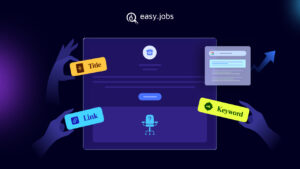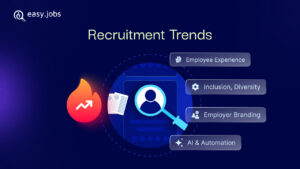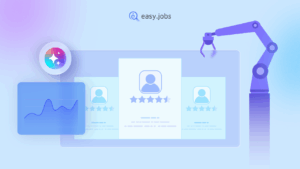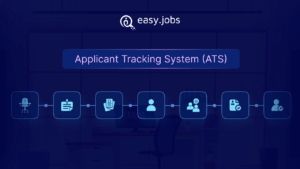Recruitment SEO is no longer optional if you want your job postings to be visible to the right candidates. Every day, thousands of people begin their job search on Google and if your postings are not optimized, they may never reach the audience you want.
Unlike traditional SEO, which focuses on long-term content like blogs and landing pages, recruitment SEO is about giving your job listings the technical foundation and relevance they need to appear in Google for Jobs.
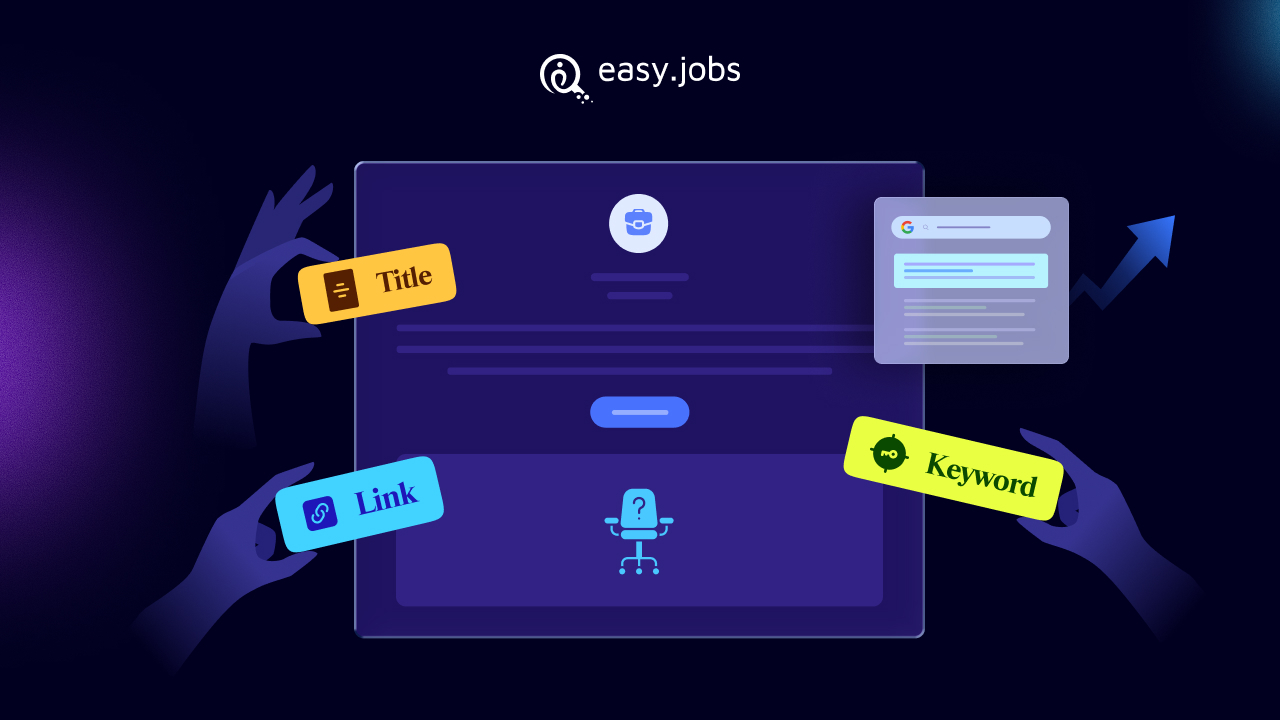
The process is not about tricking search engines. It is about following Google’s Search Essentials (formerly known as webmaster guideline) to build trust and usability into every listing. If your website struggles with core technical issues such as poor website health, slow performance, or missing security, your job postings will struggle to rank. Once those basics are strong, the focus shifts to creating helpful job content, using structured data and ensuring a clear application journey.
The good news is that you do not have to handle everything manually. Platforms like easy.jobs are built with recruitment SEO in mind, making it easier to publish optimized job postings and manage them throughout their lifecycle. In this guide, we will walk through the five pillars of recruitment SEO that directly impact your visibility and applications.
Why Recruitment SEO Matters?
When someone starts searching for a new role, the first place they usually go is Google. If your job postings are not optimized, they may never appear in those search results. This is where recruitment SEO becomes a critical part of your hiring strategy. It ensures your listings are visible in Google for Jobs and other search results where candidates are actively looking.
Recruitment SEO is not just about more traffic. It is about reaching the right candidates at the right time. A well-optimized job posting can attract qualified applicants, reduce your cost-per-hire and shorten the time it takes to fill positions. On the other hand, poorly optimized postings often go unseen, which means fewer applications and missed opportunities to connect with top talent.
The competition is high. Candidates expect clear, professional listings that are easy to find and easy to apply to. If your website or job board fails to meet those expectations, they will move on quickly. By following the five pillars of Recruitment SEO, you give your company a better chance to stand out and be trusted.
Recruitment platforms can also play an important role here. They are designed with visibility in mind, so recruiters can focus on creating meaningful content while the platform takes care of the technical side of optimization.
5 Pillars of Recruitment SEO That Increase Visibility & Application
Improving visibility in search results requires more than just posting jobs online. To succeed with recruitment SEO, you need a framework that strengthens both technical performance and candidate experience. These five pillars discussed below provide the foundation to make your job postings discoverable, trustworthy and effective in driving applications.
1. Ensure Foundational Website Health
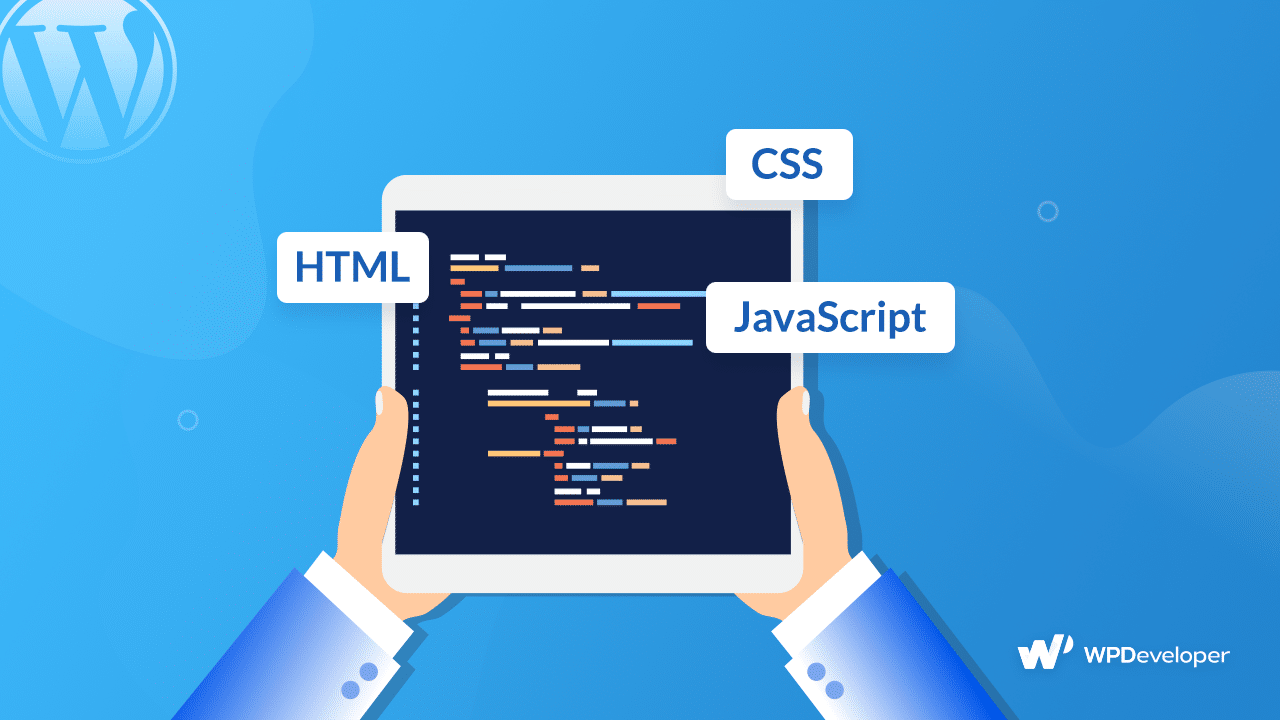
Before you optimize a single job description, your website must be healthy. Website health is the foundation of effective Recruitment SEO. If your careers page is slow, insecure, or hard to navigate, Google will struggle to index it and candidates will not stay long enough to apply.
There are four key elements of website health that directly influence job posting visibility:
- Mobile-Friendliness
Most candidates will view your job postings on their phones. If your careers page is not mobile-friendly, Google will mark it down and applicants may leave immediately. Use responsive design and test your site with Google’s Mobile-Friendly Test.
- HTTPS Security
Candidates need to trust that their personal data is secure. Without HTTPS, your site not only risks losing visibility in search results but also damages trust with applicants.
- Core Web Vitals
Google evaluates speed, interactivity and stability through Core Web Vitals. If your job page takes too long to load or jumps around as it loads, both users and search engines will see it as a poor experience.
- Crawlability
Googlebot must be able to access and understand your careers pages. Avoid blocking job listings with robots.txt or login walls. A clear sitemap and simple navigation make a big difference.
For recruiters who do not want to manage these technical details themselves, platforms like easy.jobs handle many of these requirements automatically. By using a solution built with SEO in mind, you can focus on creating better job post content while knowing the technical website health is already in place.
Strong website health is not just a technical checklist. It is the base that allows every other pillar of recruitment SEO to work effectively.
2. Create Helpful, People-First Job Content
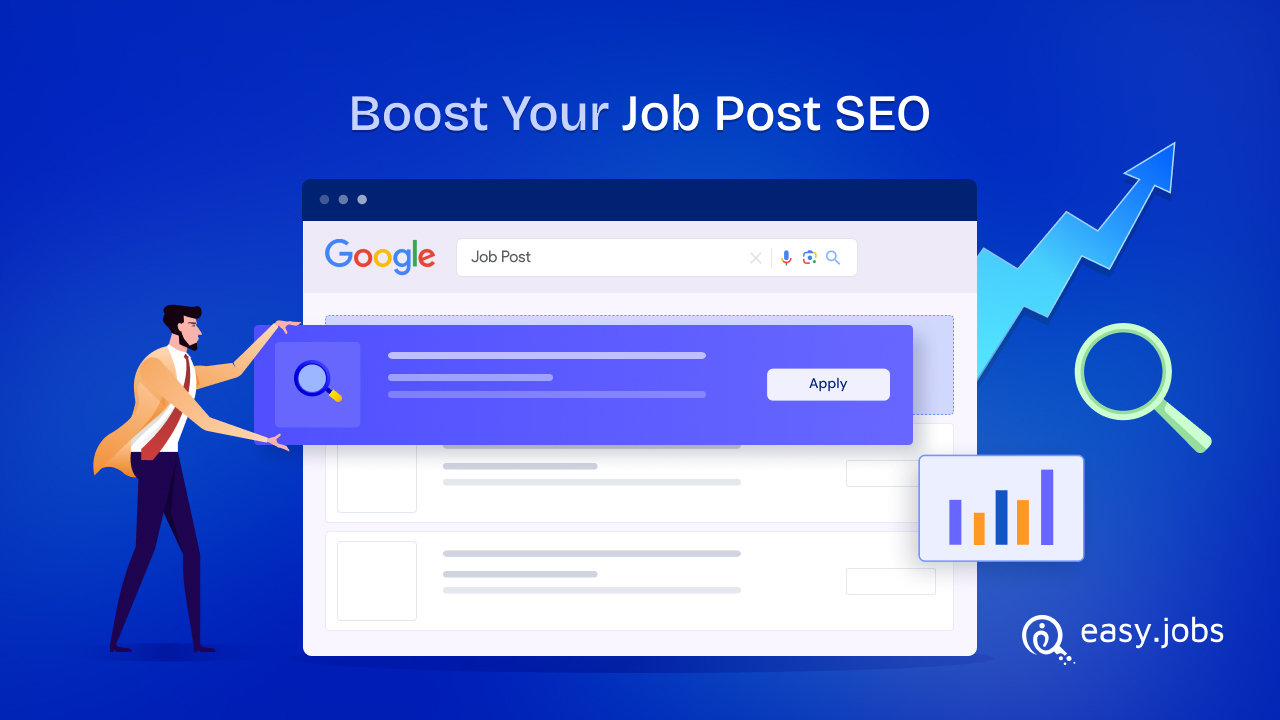
Once your website foundation is solid, the next focus of recruitment SEO is your job content. Google’s Search Essentials emphasize people-first content. That means writing for candidates, not for search engines. If your listings read like they were created only to insert keywords, they will fail to rank and fail to attract the right applicants.
There are three key principles for creating effective job post content:
- Clear And Recognizable Titles
Candidates search with common job titles like “Marketing Manager” or “Software Engineer.” Avoid internal jargon such as “Level 4 Associate” or “Tech Rockstar.” A clear title helps both Google and job seekers understand the role immediately.
- Detailed And Unique Descriptions
Copy-pasting the same description across multiple postings is a mistake. Strong job content should outline responsibilities, qualifications, and unique aspects of working at your company. Paint a picture of what success looks like in the role and why someone would want to join your team.
- Natural Keyword Use
While the job title and location will naturally appear, avoid stuffing them unnaturally into the content. A good rule of thumb is to write as if you are speaking directly to a candidate. Google rewards natural, helpful writing.
Candidates are not just looking for a list of duties. They want to understand your company’s culture, values and opportunities for growth. This makes your job content both a recruitment tool and a branding opportunity.
Make it easier to structure your job post content in a professional and SEO-friendly way. With built-in templates and formatting support, you can ensure your postings are clear, detailed and engaging without wasting time on formatting or keyword concerns.
High-quality job application content does more than attract clicks. It engages candidates, builds trust and increases applications from people who are genuinely interested in your company. That is exactly what recruitment SEO is meant to achieve.
3. Implement Job Posting Structured Data (Schema)

Even the best-written job post content may go unseen if search engines cannot understand it. This is where Job Posting Structured Data becomes one of the most powerful elements of recruitment SEO. Structured data is a type of code added to your job posting pages. It tells Google directly, “this is a job listing,” and labels the important details candidates need to see.
Why Structured Data Matters
Google uses structured data to show your postings in Google for Jobs. Without it, your listing may appear as a standard web result, buried beneath competitors who use schema correctly. By adding job posting structured data, you increase visibility and provide candidates with key information before they even click.
Required Properties
Google has clear rules about what information a job posting must include for structured data to work correctly. These details help the search engine understand your listing and display it accurately in Google for Jobs. Google specifies several properties that must be included:
- Date Posted: When the job was first published.
- Description: The full job description in HTML format.
- Hiring Organization: Your company name.
- Job Location: The physical location of the role.
- Title: The official job title.
- Valid Through: The expiration date for the listing.
Recommended Properties
In addition to the essentials, Google encourages recruiters to provide more details that improve visibility and candidate engagement. These optional but valuable fields enrich your listing and can make it more appealing compared to similar postings. Adding extra details helps your job stand out:
- Base Salary: Salary range or exact figure.
- Employment Type: Full-time, part-time, contractor, etc.
- JobLocation Type: Specify if the role is remote, hybrid or in office.
Making Schema Easier
For many recruiters, adding code can feel overwhelming. This is why using recruitment platforms is helpful. With tools like easy.jobs, the Job Posting Structured Data is automatically handled. You do not need to worry about writing or maintaining schema code, which saves time and reduces errors.
Structured data is not just a technical step. It is what ensures your job postings are visible in rich results, where candidates are more likely to notice and click. Without it, even the strongest job application content may be invisible to your target audience.
4. Ensure A Clear Application Journey

Getting your job postings to appear in search results is only the beginning. Once a candidate clicks, their experience with your site determines whether they complete the application. This is why a Clear Application Journey is such an important part of recruitment SEO. Google pays close attention to user experience. If candidates regularly drop off after clicking your listing, it sends a signal that the page is not helpful.
What Makes An Application Journey Clear?
A positive application journey should feel simple, consistent and trustworthy from start to finish. To achieve this, focus on a few core elements that shape how candidates interact with your job postings. Here are they:
Prominent Apply Button
Candidates should not have to scroll endlessly or click through multiple pages to apply. A visible, well-placed Apply button ensures they can take action immediately.
Consistency Between Listing And Page
The information in your structured data must match the job description on your page. If a candidate clicks expecting one role but finds something different, they will leave quickly.
No Misleading Redirects
Avoid sending candidates to unrelated pages, ads, or third-party forms that feel disconnected from the job itself. This frustrates users and can lower trust.
Minimal Barriers to Apply
Forcing account creation or lengthy processes often drives applicants away. A streamlined form keeps the journey simple and candidate-focused.
The SEO Connection
A Clear Application Journey does more than improve user satisfaction. It directly supports your rankings. Google rewards pages that deliver what they promise. If your job postings provide a seamless path from discovery to application, you are more likely to maintain strong visibility.
Recruiters do not need to reinvent the wheel to build this experience. Platforms like easy.jobs are designed to give candidates a clear application journey by default. With intuitive layouts and straightforward apply options, you can ensure that once candidates find your posting, they can complete the process without confusion or friction.
A clear journey turns visibility into results. Without it, even the best-optimized job post content and structured data will not lead to more hires.
5. Manage the Job Post Lifecycle
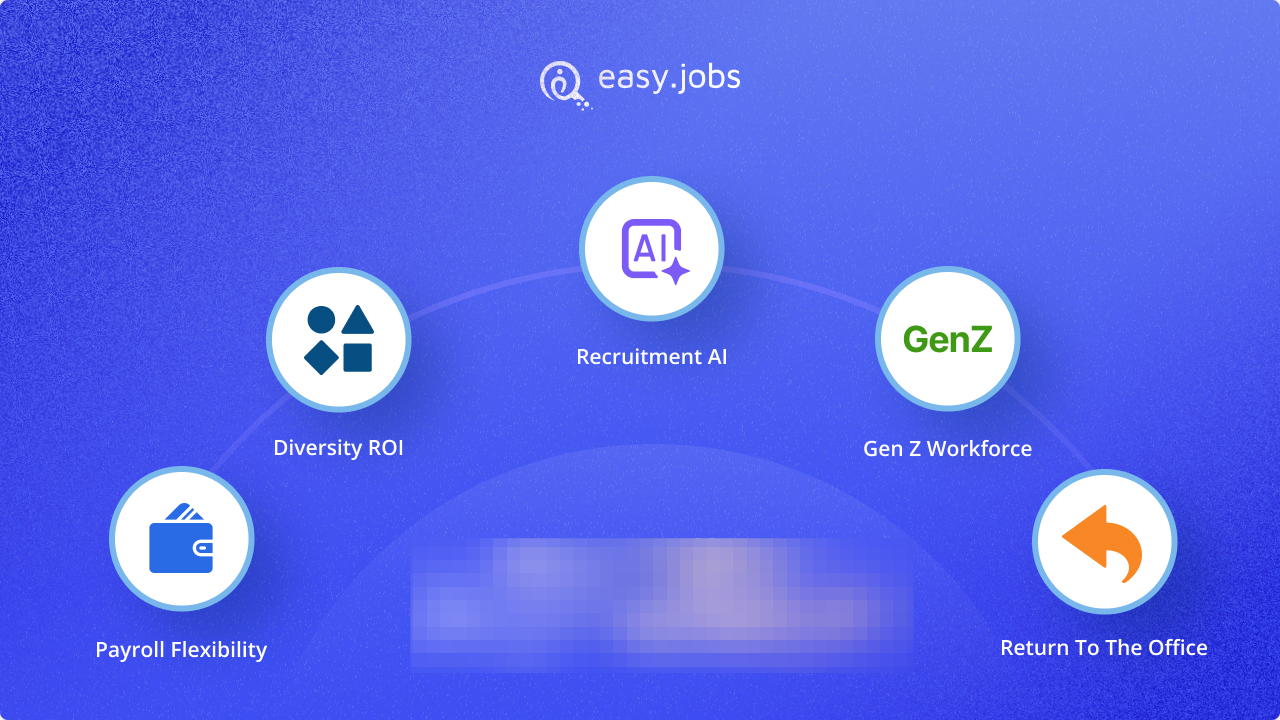
Job postings are not evergreen content. Each one has a clear beginning and end and managing that lifecycle correctly is a key part of effective recruitment SEO. If expired or outdated listings remain live, Google may reduce trust in your site and candidates will quickly lose confidence in your company.
Why Lifecycle Management Matters
Managing job postings is more than just publishing new roles. It also means keeping them accurate and removing outdated ones. Here is why lifecycle management is so important for both search visibility and candidate trust:
- Expired Listings Hurt Visibility: When candidates click on jobs that are no longer open, it leads to frustration. Over time, this increases bounce rates, which can negatively affect search performance.
- Google Prefers Fresh Content: Active, up-to-date job listings send a signal that your site is reliable. Removing or updating closed positions helps Google show candidates only relevant opportunities.
- Improved Candidate Experience: Nothing damages trust faster than applying for a role that does not exist anymore. A well-managed lifecycle protects your employer brand.
Best Practices for Managing Job Posts
To keep your job postings effective and visible, follow these best practices that maintain accuracy, trust and strong search performance.
- Remove Expired Listings Promptly: Once the validThrough date passes, the job should be taken down.
- Use Google’s Indexing API: This tool notifies Google immediately when a posting is added or removed. It ensures your listings are updated in search faster than waiting for a re-crawl.
- Handle Old URLs Correctly: Closed job pages should return a 404 (Not Found) or 410 (Gone) status code, or redirect to your careers page. This helps maintain a clean site structure.
Making Lifecycle Management Easier
Manually managing dozens of postings can be overwhelming. ATS platforms can streamline the process by automatically handling expired listings and updating visibility. This ensures your job posts remain accurate, current, and trusted by both candidates and Google.
Managing the job post lifecycle is the final step that ties all the pillars together. With healthy websites, strong job content, structured data, and a clear application journey, proper lifecycle management ensures that your Recruitment SEO efforts remain consistent and effective over time.
Common Recruitment SEO Mistakes to Avoid
Even with the best intentions, many companies miss out on visibility because they overlook critical parts of Recruitment SEO. These mistakes not only prevent your job postings from ranking but also create a frustrating experience for candidates. By recognizing and avoiding them, you can keep your hiring strategy strong and consistent.
1. Copy-Pasting Generic Job Descriptions
Reusing the same vague content for multiple roles weakens your postings. Google favors original, detailed job post content that gives candidates real value. If every posting looks the same, both search engines and job seekers will ignore them.
2. Ignoring Job Posting Structured Data
Structured data is the backbone of appearing in Google for Jobs. Without it, your listings may never show in rich results, no matter how strong your descriptions are. Forgetting schema is one of the most common but costly mistakes.
3. Leaving Expired Jobs Online
Expired listings create a poor user experience and can reduce trust in your site. When candidates waste time applying to jobs that no longer exist, they are less likely to return. Lifecycle management is essential for long-term Recruitment SEO success.
4. Making the Application Journey Too Complicated
Hidden Apply buttons, lengthy forms, or unnecessary redirects can cause candidates to abandon the process. A clear application journey is critical if you want clicks to turn into applications.
5. Overloading Keywords
Stuffing job titles and descriptions with repetitive keywords might seem like a shortcut, but it does more harm than good. Google prioritizes natural, people-first writing.
Using a recruitment platform can help avoid these mistakes by providing built-in templates, structured data automation and lifecycle management features. This ensures your focus stays on creating strong, candidate-friendly postings while the technical details are taken care of.
Avoiding these pitfalls will put you ahead of many competitors who still overlook the basics. With careful attention to detail, your recruitment SEO strategy can consistently deliver visibility and better applicants.
How Recruitment SEO Fits into Your Broader Hiring Strategy

Optimizing job postings for Google is powerful on its own, but recruitment SEO should not stand alone. It works best as part of a complete hiring strategy that combines visibility, candidate experience, and long-term employer branding.
Recruitment SEO And Employer Branding
When your job listings appear high in Google search results, they do more than attract applicants. They strengthen your company’s visibility as an employer of choice. Every clear, detailed, and professional posting reinforces your brand in the minds of job seekers.
Reducing Cost And Time-to-Hire
A strong optimised recruitment strategy ensures more qualified candidates see your roles without relying solely on paid ads. This lowers your cost-per-hire and helps you fill positions faster. Instead of chasing applicants, your postings attract them naturally.
Supporting Other Hiring Channels
SEO is not meant to replace job boards, referrals, or social recruiting. Instead, it complements them. A candidate who discovers your role on Google may also explore your career site or follow your company on LinkedIn. Recruitment SEO expands reach while strengthening other channels.
Making It Scalable
For growing businesses, managing all the moving parts of recruitment SEO, technical health, job post content, schema and lifecycle can be overwhelming. Platforms like easy.jobs integrate these pillars into one system, making it easier to scale hiring without losing visibility or consistency.
Recruitment SEO is not just a technical process. It is a strategic asset that connects your employer brand with the right candidates at the right time. When combined with a broader hiring plan, it turns visibility into lasting results.
Boost Your Recruitment Faster & More Visible
Recruitment SEO is not about tricking Google. It is about trust, value and giving candidates a smooth experience. The five pillars: website health, job content, job posting structured data, a clear application journey and lifecycle management work together to make your listings visible and effective.
Each step builds on the other, turning clicks into applications. Recruitment SEO is ongoing, not a one-time fix. Using a recruitment platform simplifies much of this process, so you can focus on attracting the right talent and improving your hiring results.
If you found this guide helpful, subscribe to our blog to get fresh insights, tools and strategies for smarter hiring and stronger teams. You can also join our Facebook community, where HR professionals and business leaders share ideas, discuss challenges and learn from one another. It is a space to connect, grow and stay ahead in recruitment.

